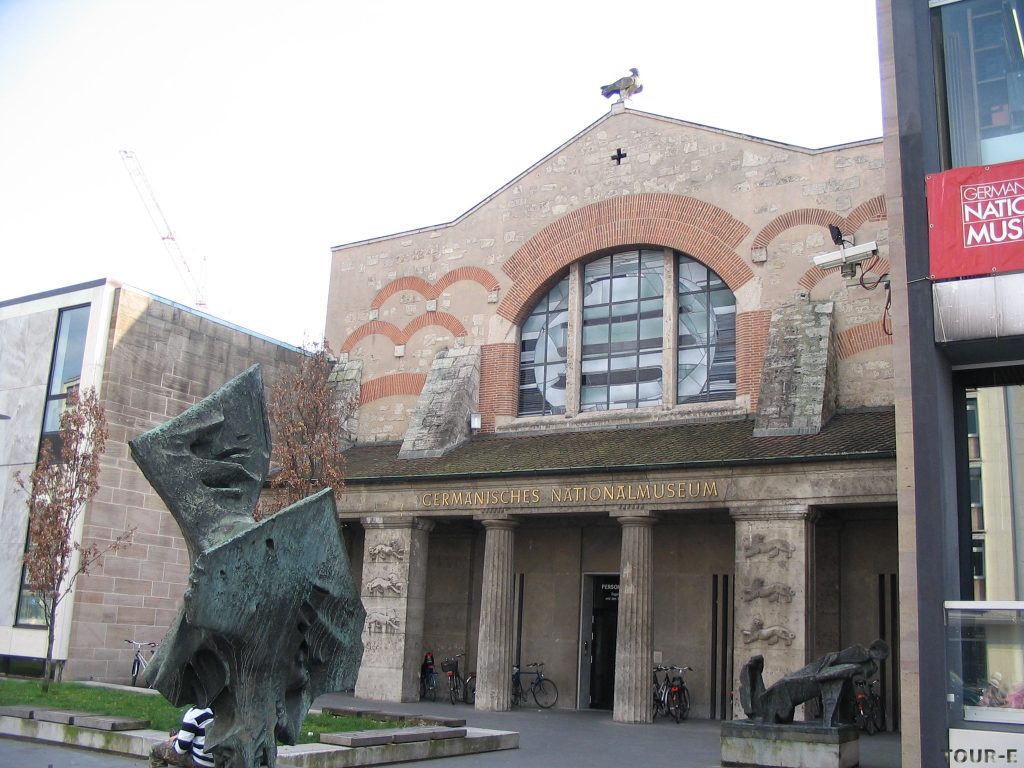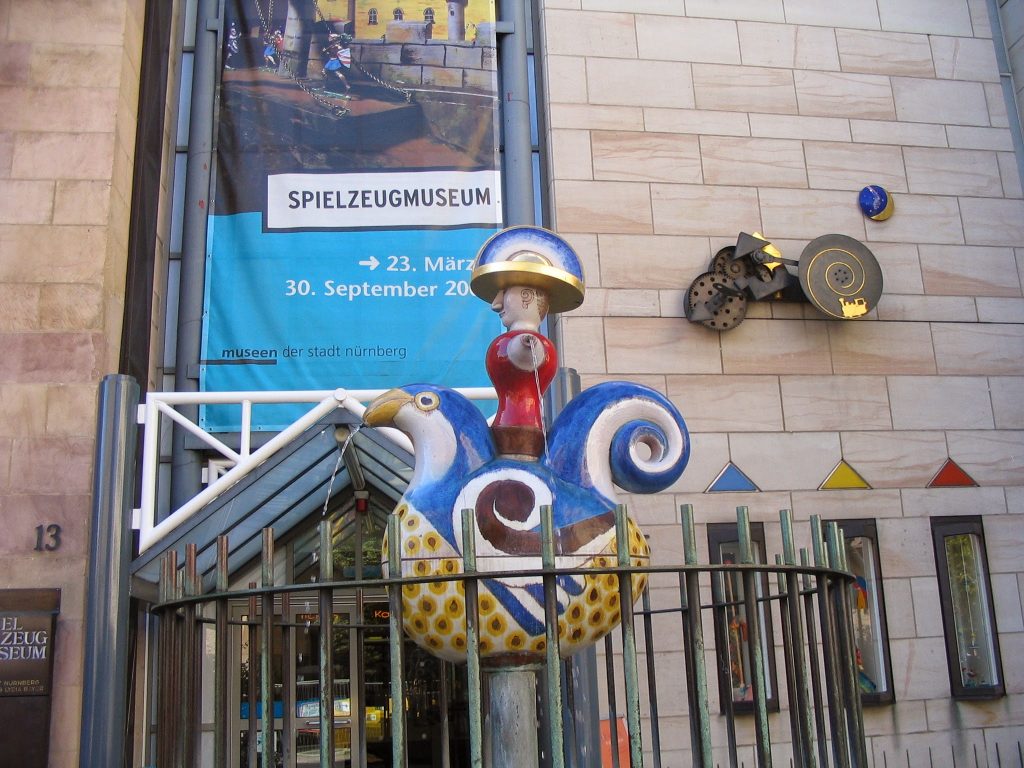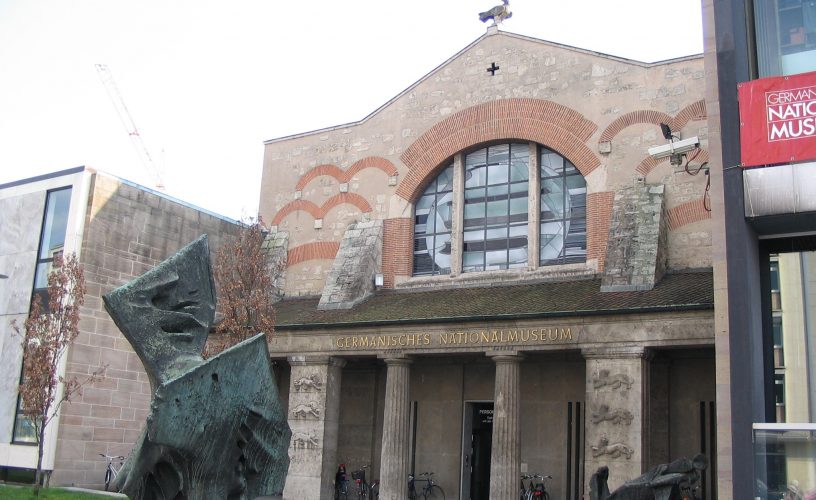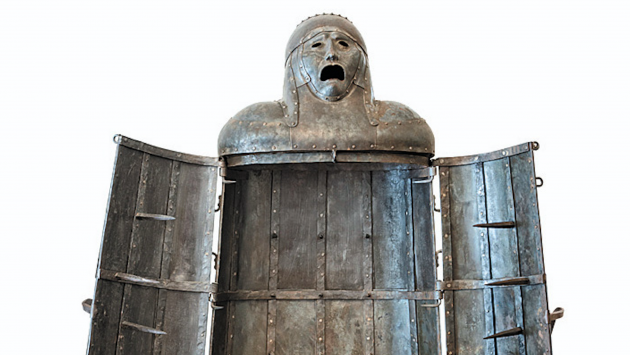Nuremberg Museums
Nuremberg Museums
Documentation Centre Reichsparteitagsgelände
An der Kongresshalle
Opening hours: Mon. – Fri. 9 a.m. – 6 p.m., Sat. & Sun. 10 a.m. – 6 p.m.
The permanent exhibition “Fascination and Violence”, which covers an area of 1200 m2, documents the connection between ideology and the architecture of the Third Reich. The 130 m pole made of metal and glass that has been driven through the north wing of the Congress Hall is intended to symbolise and elucidate the break with the ideology of that time.
Museum itself has several places, that starts from the beginning to these days. Just the waiting for these documents to be opened was the real intrigue not just for the Germans, and the citizens of the town of Nuremberg, but for the whole world. The whole museum was made so that we can learn something from our own history, but partly to keep us warned that this kind of thing should never happen again. Nuremberg, being the town where the Nazi Partie held its rallies from 1933. forward, there is also material from that time.
In this museum, there are exhibited pictures, video materials, letters, and many other relics from 1939. all the way to the end of the war in 1945.
The second part of the exhibit is called ‘Education Centre’ where the youngest and the ones that don’t know about German history that much, can learn everything from the beginning of the war, its causes and consequences, so that all of them can learn a lot about how the Second World War started, and how to recognize the signs that something like that can happen again.
The documents were made public in 2001., and from then, every tourist should see the museum on the whole.
Germanic National Museum
Kartäusergasse 1
Opening hours: Tues. – Sun. 10 a.m. – 5 p.m., Wed. until 9 p.m.
The Germanic National Museum was founded in 1852 in order to give an overview of German culture, literature and history. The appearance of the museum has been changed many times during rebuilding work. The rebuilding work was completed for the time being in 1993. There are now approximately 20,000 exhibits of culture in German-speaking countries on display here.
Among its permanent exhibitions are pictures from the 19th century, they are also proud of the early 20th century pictures and sculptures, there are clothing dating back to 1700. which was pretty hard to wear, art collections of the Baroque period, including some of the most valuable pieces, made on those grounds as well as medicine crafts, which look scary, and keeping us humble and grounded because of new inventions that are a cure for these days. There are also many sculptures from the middle ages, that survived to this day, which make this museum so important and worth visiting.

New Museum
Luitpoldstraße
Opening hours: Tues. – Fri, 10 a.m. – 8 p.m., Sat. S, Sun. 10 a.m. – 6 p.m.
The museum, opened in April 2000, houses examples of applied and liberal arts. The 100 metre-long glass façade located on a historical square is the connection between modernity and tradition. There is a total exhibition area of 3000 m2, 700 of which are for temporary exhibitions.
In front of this modern museum, there is a permanent exhibition, made of a Gate along with 27 columns of concrete and a row of the oak tree, and three of them are on the ground.
On every one of these 27 columns is written with the laws of the Declaration United Nations, and on two plates on every column, from which one is in German and the others are in different languages of the world, of which all of them are members of United Nations.
City Museum Fembohaus
Burgstr. 15
Opening hours: Daily 10 a.m. – 5 p.m., closed Mon.
The building of the Fembohaus was commissioned by a merchant and is the only completely preserved townhouse from the Baroque period.
The museum has been restored and opened its new rooms to the public in March 2000.
The four floors of the museum contain a modern portrayal of the history of the city. All 950 years of fragile history of this town is, after the renovation, placed there from all parts of the town. Some of the earliest works are still untouched, and these days the museum has a lot to offer from the history, dating back the whole century.
Now, this is the place where except the artwork, you can come here and listen to old radio recordings, and famous speeches, and sometimes amateur theatres from the city has its plays here because some part of the museum still looks like a pleasant home to live in.
Toy Museum
Karlstr. 13-15
Öffnungszeiten: Di. – So. 1D -17 Uhr, Mi. bis 21 Uhr
The Toy Museum was opened in 1971 and offers Dürer year an exhibition of the development of the toy over three millennia. Besides, attempts to show the importance of games and toys in a variety of forms.
It’s located in Old Town of Nuremberg, and it offers tourist and citizens insight in the early years of toy-making. From the famous dolls which were made first, and many of them find its way to the museum, to the industrial revolution, at which point they started making tin toys like locomotives with cargo behind it, or the small kitchen appliances for the small doll houses, all of that and many more can be found in the toy museum. Also, this museum is home to newer toys like Lego, Barbie doll or Playmobile, which is the right place to go with children, if you get tired of walking around town. For those who come in the middle of the summer, there is an open playground for kids, and on the secluded playground is a place for elders called “Café in the Toy Museum”

Nikolaus-Kopernikus-Planetarium
Am Plärrer 41
Shows: Wed. & Thurs. 4 p.m. and 7.30 p.m., Sat. & Sun. 2 p.m. and 4 p.m.
The Planetarium, which was opened in 1960, has several special projectors and puts on a variety of different shows.
In February of 1925., first lenses were purchased to have better viewing of the planets, stars, and other objects in the sky, and the first telescope was made, which was pretty early for the time, but knowing the history and education in the town, it really needed the telescope to see the stars, and to explain them to younger people.
Nowadays, this is one of the largest planetaria in Germany, along with its education centre for elders, and the Nuremberg city library, it becomes Der Bildungscampus Nürnberg, or ‘The Campus of Nuremberg’.
Along with the Educational Centre, there is also Nuremberg City Library. The last count that Planetarium presented was from 2016. in which 70.874 visitors were counted, which made it one of the most visited places in this town. The dome of the Planetarium is high 23 meters, and the first telescope was put there in 1925. After the war was ended, the projector was repaired by the Zeiss factory in 1961., and on December the 11th was presented to the public, remembering Kopernikus, and 500 years of his death.
Dungeons
Rathausplatz
Opening hours: Apr. – Oct. Tues. – Sun. 10 a.m. – 4.30 p.m., in winter Tues, – Fri. 10 a.m. – 4.30 p.m.
The dungeons are located directly beneath the town hall. The cells convey an impression of the conditions in a medieval prison. The room marked “Chapel”, which was, in fact, the torture chamber, documents the interrogation methods of that time.
It was there since the 14th century, and it served for interrogations as well as for safekeeping of the prisoners of the town. Down there are still twelve small and depressing dungeons with the torture chamber, and the objects are still there to present the sad time of this town. In those times, that was the usual and pretty commonplace for keeping and torturing the prisoners, which were sometimes, wrongly accused. All that is still there, and one of the scariest museums in town, but for those who prefer these things, the dungeons are the place to visit any time of the year.
Art Gallery
Lorenzer Str. 32
Opening hours: Tues. – Sun. 10 a.m. -6 p.m., Wed. until 8 p.m.
Since 1967, the art gallery has housed temporary exhibitions of modern and contemporary art. The central focus of the exhibitions is the examination of new directions in international art.
Since April 2018. this museum was closed due to the renovation of the roof, that was threatening to ruin all the artwork inside, and to control humidity, they had to install the new heating system, so until this museum opens again in late summer of 2019., the museum holds moto ‘Off with the Show’. One of the cross-media exhibitions that were held until the renovation was ‘Fiona Banner. Scroll down, and keep scrolling.’ One of the standard exhibition was also Alicia Framis, with the stunning exhibit named ‘fearless’, where she looks at the book of Human Rights and living in the real world, where all the boundaries of those rights are being destroyed and violated every single day, where the ones who can help, don’t even bother.
Anyway, if you decide to see a new artist looking at the world with different eyes, wait until the middle of this summer, and then you will have the real chance to see many nice, and beautiful looks on the world, along with the others, who are concern with the way our society is going.
Kaiserburgmuseum
Burg 13
Opening hours: Apr. – Sept. 9 a.m. -12 p.m. & 12.45 – 5 p.m., Oct. – Mar. 9.3D a.m. – 12 p.m. & 12.45-4 p.m.
The Kaiserburg Museum is a branch of the Germanic National Museum and is chiefly concerned with medieval defence engineering and the weaponry of that period.
On display they have the authentic weapons that are made in real collections, separated by the period they were used in. The permanent exhibition of the Imperial Castle Museum offers insight into the architectural craftsmanship of the age the Castle was made. Not only that, but the fact that the Castle still stands tells a lot about the people who made it.
The most exhausting thing to even look at is the armoured suits, that were sometimes heavier than the person wearing it, but on most occasions they saved lives, so it was worth carrying them in whole, along with the shield, that always came in handy when the war was raging.
Museum of Industrial Culture
Äußere Sulzbacher Str. 60-62
Opening hours: Daily 10 a.m. – 5 p.m., closed Mon.
The museum has been located in a former ironworks since the mid-1980s. The temporary exhibitions document and investigate the way life changed in the age of industrialisation. The living conditions of the time are shown in replica interiors from the end of the 19th century.
The museum is placed in the old factory where screws were made, and renovation made it into a place where less or more famous objects can be seen as a part of exhibitions. One of them is dating back to the first steam engine, some are looking into a flats of ordinary working people which can fit in a smaller room, and how about a talking kitchen? All and much more that is worth seeing. There are also bike collection, motor-bike collection, and something unusual as a ‘Little story about hangers’, experiments with the microwave oven, the competition of the best photo etc.
Natural History Museum
Marientorgraben 8
Opening hours: Daily 10 a.m. – 5 p.m., closed Sat.
The Natural History Museum in the Norishalle houses exhibits dating from prehistoric and early historic times. In addition to this, there are minerals and fossils from all geological eras and exhibits about ethnology.
Among the permanent exhibitions are prehistoric, ethnology, Cave excavations, geology, Jordan exhibition, ecology, the museum of history, the Energy-Saving project, Museum of Mundial, and the Plan of the Museum.
Besides permanent, there are Special exhibitions, from which now, up to the end of April 2019. you can see the exhibition by the name ‘ Tolerance, Understanding and Coexistence, Oman’s Message of Islam, where the itinerary is being separated by the days, where each day you can learn something new, you didn’t now to this day.
Transport Museum
Lessingstr. 6
Opening hours: Tues. – Sun. 10 a.m. – 5 p.m.
The first train ran between Nuremberg and Fürth in 1835, and the Transport Museum was opened in 1899. In 1902 the museum was extended to include the section about the postal system. It is, therefore, one of the oldest transport museums in Europe, documenting the development of the postal and railway systems in Germany. The entire history of the railways, from historical trains to the modem ICE (Inter-City Express) is vividly brought to life here.
The museum consists of the Deutsche Bahn’s relics and of the Museum of Communications, and everything that was being used since the first locomotive went through town. The exhibitions that are there always are the historical railway vehicles including The parts of the Bavarian train for the King, Ludvig the Second, Steam locomotive, and from recent times, The Trans Europ Express diesel railcar dating back to 1950s, and many more objects that will amaze you.
Rock-cut Cellars
Bergstr. 19
Guided tours: Daily from 3 p.m.
The rock-cut cellars are located under the castle district. They are a system of cellars on four levels hewn into the sandstone in order to ventilate the castle. As well as this, some water audits can still be seen there. In the course of the centuries, the cellar and corridors were used to store wine and food.
This is, again, the largest cellar labyrinth in whole Germany, where in the past, citizens of the town dig out for their own purposes cellars in the sandstone under the town. The first time the cellars were mentioned in writing in 1380. For all that time, and after, the toms were serving the purpose of making and storing freshly made beer.
Even today, some of the parts of the labyrinth are still holding rare beer, and it’s been used for beer storage, and some are waiting for the beer to mature in there.
There is a special room, called Escape room, where you can be put in, as a part of the tour, and you have 60 minutes to find your way out of there, and as a reward, you will get the voucher that will cover your expenses in the part of the cellar where you can enjoy beer from almost any age. If you are up to the challenge, the ticket for the finest beer can be yours.
Historical Tram Depot
Schlossstr. 1
Opening hours: 1st weekend of the month 10 a.m. – 6 p.m.
There has been an exhibition giving an overview of historical vehicles in the disused tram depot since 1985. These include an old horse-drawn tram and a working model tram.
This special museum holds over 130 years of history, and if going with your tour, you’ll have a great experience. Including some of the things that are nor in relation to this museum, its main part is presenting the history of public transportation, and that’s not only in town but also the means of transportation during the years.
In addition of being a museum, here you can have any kind of gathering and celebrations, like for example, you can have a wedding here, like one of the most unusual places to get married, where there are round tables, for 8 people at the time, and the maximum of 200 people.
In addition of being used for all types of gatherings, if you are part of the tour, you can relax in one of the trams that stands still, and works as a coffee, or rather, the beer cafe.
The only thing one should keep in mind is that this place is not always opened, due to cold weather from late October to the middle of the March, having in mind that not everything that is of importance is during the winter.


